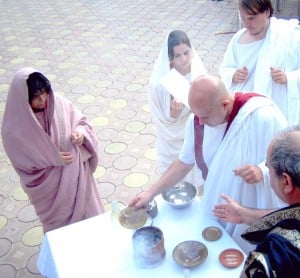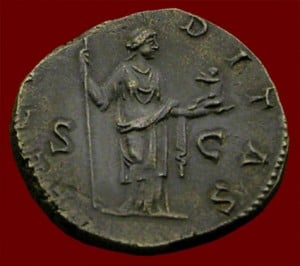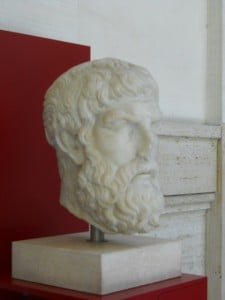The Latin term ritus means means a rite that is performed in the customary and usual Roman manner (Festus s. v.). More specifically ritus refers to a Roman rite where prayers are correctly spoken, and the customary gestures and actions of Roman ritual are used. It is a marriage of prayer and action where the words giving meaning to an action and the action gives substance to the words. Furthermore a Roman ritus can be said to be composed of four parts:
I The Approach
II The Gesture and Prayer
III The Request
IV The Reply
 One ought to know which God or Goddess he is calling upon, what are appropriate offerings to bring for the deity, how to address a particular God or Goddess, when and where to perform the ritual and other considerations. This can be a little complicated in any polytheistic tradition, but there is always a certain internal logic in a tradition that aids a worshiper when approaching a God. In the Roman tradition there is even a traditional manner of approach when you do not know what God or Goddess might be present in a place. The prayer and gesture is generally specific to the kind of rite being performed, where as a request may be more specific to the occasion or desire. Not always, but during a formal Roman rite one also takes a moment to see whether any sign appears to indicate whether one’s offerings have been accepted or reject in reply to your request. This sounds more complicated than it actually is in practice.
One ought to know which God or Goddess he is calling upon, what are appropriate offerings to bring for the deity, how to address a particular God or Goddess, when and where to perform the ritual and other considerations. This can be a little complicated in any polytheistic tradition, but there is always a certain internal logic in a tradition that aids a worshiper when approaching a God. In the Roman tradition there is even a traditional manner of approach when you do not know what God or Goddess might be present in a place. The prayer and gesture is generally specific to the kind of rite being performed, where as a request may be more specific to the occasion or desire. Not always, but during a formal Roman rite one also takes a moment to see whether any sign appears to indicate whether one’s offerings have been accepted or reject in reply to your request. This sounds more complicated than it actually is in practice.
A relatively simple rite is called the adoratio. It may involve a simple greeting such as saying “Ave, Ave, Di parenti.” This greeting is coupled with a gesture where in one kisses the back of the right hand just behind the knuckle of the index finger, and then touches the finger tips onto an altar or an image. It is specifically used when addressing one’s ancestors, so one approaches a family member’s tomb, or the family lararium within the home, or sometimes it might be a tree or other outdoor shrine. The adoratio was so closely associated with rites for deceased family members, that is could be used interchangeably for the annual ritual owed to the dead in a parentatio. An adoratio can also be used with certain celestial deities when They are approached in a parental way. One example from Roman literature is where a woman would stop by each shrine and image of Venus, calling upon the Goddess to lend her daughter beauty and poise. In word and action the mother both promised Venus sacrifices in the future while reminding Her of past sacrifices, while at the same time she was including Venus as a parental figure to her daughter and thereby asked Venus to take a special interest in the welfare of her daughter.
The gestures, prayers, and particular manner in which a Roman pours incense or wine as an offering on an altar can be called a “rite.” A Roman ritual is then composed of a series of rites. As we move forward, I shall break down a Roman ritual into its component parts and it is easiest to think of a ritual as having been built up from little ritual moments.
The Latin term caeremonium means “ritual” in the sense I gave above. But I shall use it instead to mean “ceremony” in the sense of a sequence of rituals. Roman celebrations could extend over several days, with a variety of rituals performed for several deities. For our purpose, then, “rite” or ritus will refer to a ritual act, like a building block, for a Roman ritual, which in turn serves as a building block for a formal Roman ceremony.
There are two modes of performing Roman ritual. The first is called ritus Romanus that Romulus brought from Alba Longa to Rome. Ritus Romanus was performed in the Latin fashion with the toga pulled tightly around the torso (cinctus Gabinus) and drawn up to veil the head (capite velato). For certain rituals conducted in ritus Romanus, animal sacrifices were prohibited. In others, animal victims were selected according to the deities for whom they were meant as offerings. In general, white victims were selected for celestial deities, black victims for deities of the Underworld, while red victims were preferred for Vulcanus and Robigo. Goddesses generally received female victims. There were always exceptions, with each temple having its own rules on sacrifice. Gods received male victims that were first castrated, except in sacrifices for Mars, Neptunus, Janus, or a genius. How the animal was decorated was another consideration, depending on the deity and the particular festival – whether gilt horns were to be used, the color of ribbons (red, white or black in most instances, blue for Neptune), a wreath of bread at some festivals, otherwise a wreath of flowers and fruits in some cases, and the embroidered dorsuale was draped over the flanks of oxen. Other kinds of offerings were likewise selected according to the particular deity or the particular festival. Milk was used as a libation in the oldest rites. Generally Goddesses received milk libations, although there are exceptions here too. Venus is one Goddess Who usually receives wine as a libation. Where wine is the libation commonly used in Roman ritual, wine is prohibited in some rites. All of the rules of ritual were once kept in the pontifical books. Commentaries on these lost books have since preserved some of the requirements of Roman ritual for us.
In spite of its name ritus Graecus is wholly a Roman style of performing ritual. Legend held that before Romulus came to Rome a Greek named Evander had established a settlement in the area. Legend also told how Hercules had come to Italy and first established the rites conducted at the Ara Maxima. Thus ritual held for Hercules and for Saturnus, among others, was conducted in ritus Graecus. Also when some Greek deities were adopted into the Roman pantheon, Their festivals could be celebrated in ritus Graecus, although, once again, there were exceptions like Castor and Pollux. Ritus Graecus was performed without the head being veiled. Instead wreaths were worn, usually made from woven laurel branches or flowers. When women took part, they are sometimes mentioned as having been barefoot. The same prescriptions on sacrifices used in ritus Romanus would seem to have applied as well in ritus Graecus. Perhaps more closely identified with ritus Graecus were other types of offerings. Music, dance, theatrical performances were always performed at festivals as an offering to the Gods, not as entertainment for the public. Special hymns would be composed for the Gods, sung as an offering, just as poetry and theatrical contests were held in Their honor. Certain dances performed by mimes that were introduced from Campania were more closely associated with ritus Graecus than with ritus Romanus. But then, there were celebrations such as those conducted by the Salii who danced in celebrations of Mars and sacrificed in ritus Romanus. Horse races seem to have been associated more with ritus Romanus; chariot races more often with ritus Graecus. Ritus Graecus is also more closely associated with certain kinds of ceremonies called lectisternia, sellisternia, and supplicationes. The prayers used in ritus Romanus are more direct, sometimes becoming contractual, where as prayers associated with ritus Graecus might tend towards hymns of praise or invocations that recall myths and titles and honors of the deity. Along with a different style of prayer, the gestures used in ritus Romanus may have been distinct from those used for ritus Graecus.
By the Late Republic such distinctions made little difference. Caeremonia were composed of several rituals, and as Roman ritual grew more elaborate, with sacrifices offered to several deities, a caeremonia might pass from ritus Graecus to ritus Romanus and back again several times as each God and Goddess received what was most appropriate. Also adopted during the Late Republic and into the Imperial periods were foreign ceremonies that, although performed in Rome, were still held separate from the religio Romana. Such celebrations were thus conducted in a ritus peregrines, or in a foreign manner.
Every family, every clan or gens, every temple, shrine, and altar had their own traditional rituals, many of which changed over time. If anything can be said about Roman practice it is that is vastly diverse and that it was continually evolving throughout time. Trying to condense it all down into something understandable for a modern practitioner will thus overlook some things even as I try to develop some of the details that cultores Deorum Romanorum follow today.















